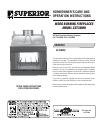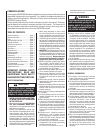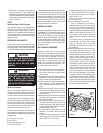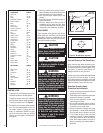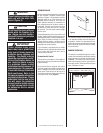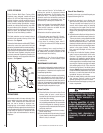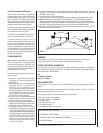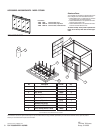
6
NOTE: DIAGRAMS & ILLUSTRATIONS ARE NOT TO SCALE
Twice A Year Check-Up
Normally, twice a year, you should inspect your
fi replace following this list:
1. Inspect the opening in your chimney top
and remove any debris that could clog it.
The cap is usually held in place by four (4)
screws, which remove easily for checking
or cleaning the full length of the fl ue from
above. Remove the chimney top while wear-
ing gloves to guard against any sharp metal
edges.
2. Inspect the entire fl ue from the top down for
obstructions such as birds nests, leaves, etc.
This may be done by using a fl exible handled
chimney cleaning brush. If the chimney
contains offset/return elbows; a soft brush
cleaning from the top down to any elbow and
then from the fi rebox up to the offset/return
section is the proper method. The beam
from a powerful fl ashlight will help in this
inspection.
3. Look up from inside the fi replace (damper
open) to see any obstructions in the lower
fl ue area. If present, shut the damper and
glass doors (if installed) to seal the fi rebox
and contain any soot that might fall. If your do
not have glass doors installed, a damp sheet
covering the fi replace opening and sealed
with masking tape will do. Then clean the
fl ue from the top down (if an offset system,
clean per Step 2) using a proper size chimney
brush with fl exible pole sections. Don’t open
the doors or remove the sheet until all soot
has settled. Vacuum, don’t sweep.
4. Check the metal fl ashing and seals around
your chimney. Seal any cracks or loose
nailhead openings to prevent roof leaks.
5. Clean the fi rebox thoroughly by using a soft
brush or equivalent.
LINTEL EXTENSION
These Custom Multi-Open Factory-Built
Fireplaces were designed, tested and listed
with an 18" (457 mm) high viewing area, fl oor
to lintel. However, varying conditions such as
altitude, climate, wood type, moisture content
of fuel, dwelling design peculiarities, average
ambient air pressure and humidity may effect
the performance of this fi replace. If an unac-
ceptable amount of smoking occurs while the
doors are open, the adjustable lintel can be
moved to correct the smoking condition.
The lintel extension can be lowered using a
predrilled hole located at the top of the lintel
extension. See Figure 6.
To lower the lintel extension on Model CST38MH,
remove the screw from each end of the lintel
extension (located behind the screen assembly).
Slide the lintel extension down and align the
upper holes in the lintel extension with the holes
in the lintel frame. Reattach using the screws
previously removed. Repeat this procedure for
the lintel extension on the opposite side of the
fi replace. See Figure 6.
Proper care and “burn-in” of the fi rebox will
prolong the period of enjoyment without
extensive maintenance. For the fi rst few uses,
build small fi res – not roaring infernos. The
materials used in the refractories contain and
absorb moisture. It is important to “cure” the
refractories by building only modest fi res.
Under normal usage, it is expected that hairline
cracks will appear in the refractory surface.
These hairline cracks do not affect the safe
operation of the fi replace.
Refractories should be replaced when:
1. The crack opens more than 1/4" (19 mm).
2. Pitting in the surface is extensive and pits
become deeper than 3/16" (4.76 mm).
3. Any piece of refractory larger than 2"
(51 mm) in radius and 3/16" deep becomes
dislodged.
If your refractory has a crack less than 1/4"
(19 mm) in width, a simple Refractory Patch
Kit, Model RPK, can easily be used to fi ll the
crack and repair the refractory.
If conditions 1, 2 or 3 occur, the refractory
should be replaced. For minor defects, repair
as noted above.
MAINTENANCE GUIDELINES
Your fi replace is designed to operate trouble-free
with minimum maintenance. However, like any
fi ne appliance, it deserves and requires some
housekeeping attention.
Your fi replace will perform better, and certainly
look more attractive to family and friends, if
it is cleaned before each use. Before the fi rst
seasonal use in Autumn and after the last fi re
in Spring, it is important to inspect the fi replace
system carefully. We recommend at least two
complete fi replace inspections a year.
Before Each Use
1. Clean the fi rebox of excessive ashes. Some
owners prefer to leave a small layer to
insulate the cold refractory below the grate
which helps fi re starting.
If your particular model fi replace has a fac-
tory supplied grate attached, it is permissible
to remove the grate for cleaning; however,
the grate must be re-attached to the fi replace
before the next burn.
2. Keep the fi replace screens clean so combus-
tion air fl ows freely.
3. Spot check the brick-like refractory for small
cracks. Heat from the fi re expands it slightly.
When it cools, it contracts.
Figure 6
Original Position
Lintel
Extension
Lintel
Frame
Lowest
Position
2" (50 mm)
1"
Front
Frame
WARNING
Continued overfi ring can perma-
nently damage your fi replace
system. Some examples of
overfi ring are:
• Burning quantities of scrap
lumber, pine branches, paper or
cardboard boxes which exceed
the volume of the normal log
fi re.
• Burning trash, chemicals or
chemically treated combus-
tibles.
REFRACTORIES
All fi reboxes contain a furnace refractory fl oor.
Some models also have refractory sides and
backs. These refractories are reinforced with
steel, but can be broken by improper use.
Dropping logs on the bottom refractory and
building fi res directly against the refractories can
cause premature burnout of these components.
It may easily be repaired or replaced at costs
far below repair and maintenance for masonry
fi replaces.



